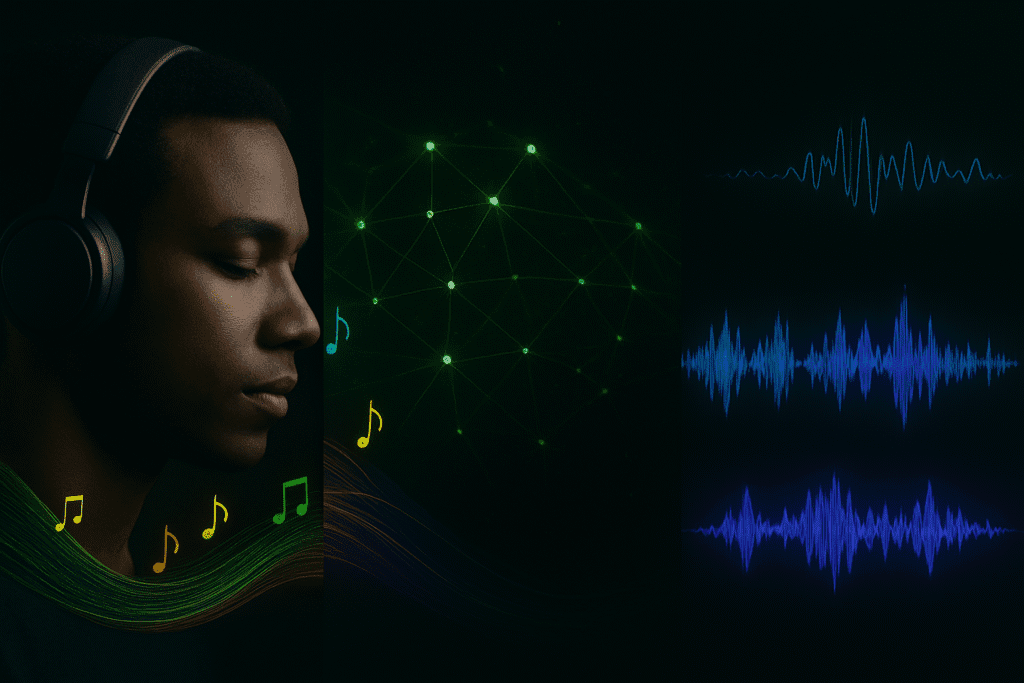The Mind Reader in Your Pocket
Ever wondered how Spotify seems to know your music taste better than your closest friends? Every Monday, over 100 million users discover their Discover Weekly playlist—30 songs they’ve never heard before but somehow feel perfectly curated for them. It’s not magic, though it might feel like it. It’s one of the most sophisticated machine learning systems ever deployed at consumer scale.
Spotify’s recommendation system operates on three fundamental approaches: collaborative filtering, natural language processing, and audio analysis. This trinity of technologies creates what feels like musical telepathy but is actually algorithmic precision operating on massive datasets.
Collaborative Filtering: The Wisdom of Crowds
At its core, collaborative filtering analyzes the listening behavior of millions of users to identify patterns and similarities, using the collective tastes of Spotify’s vast user base to predict what individual users might enjoy. Think of it as musical DNA matching; if you and another user share 80% of your favorite artists, there’s a high probability you’ll enjoy that one artist the other person loves that you haven’t discovered yet.
The system uses algorithms like BART (Bandits for Recommendations as Treatments) that examine listening habits of similar users. When User A with similar tastes to User B discovers a new song, the algorithm flags it as a potential recommendation for User B. This creates a continuous feedback loop of musical discovery across the platform’s ecosystem.
Natural Language Processing: Reading Between the Lines
Spotify’s acquisition of music analytics firm The Echo Nest in 2014 marked a turning point, merging machine learning with Natural Language Processing to refine content-based filtering capabilities. The system doesn’t just listen to music, it reads about it.
Every day, Spotify’s NLP algorithms crawl thousands of music blogs, reviews, and social media posts, analyzing how people describe artists and songs. Words like “dreamy,” “aggressive,” or “nostalgic” become data points that help classify music beyond traditional genre boundaries. This contextual understanding allows the algorithm to recommend songs that match not just your sonic preferences, but your emotional state and cultural context.
Audio Analysis: The Digital Ear
Spotify’s audio model uses sophisticated machine learning algorithms to perform detailed analysis of raw audio signals in each track, breaking down music into components such as tempo, pitch, and timbre to capture subtle nuances. This is where the magic really happens.
To learn vector representations, Spotify uses Google’s Word2vec suite on the catalog’s most popular songs, specifically the Continuous Bag-of-Words (CBoW) algorithm with negative sampling, taking user-created playlists as input. This mathematical approach transforms songs into numerical vectors, making it possible to calculate musical “distance” between tracks with startling accuracy.
The Exploitation vs. Exploration Balance
Spotify uses a combination of exploitative and explorative algorithms, exploitative recommendations use existing data on likes and dislikes, while explorative content introduces users to entirely new musical territories. This balance prevents the dreaded “filter bubble” while still giving users the comfort of familiar sounds.
The system constantly weighs whether to serve you something it knows you’ll love (exploitation) or challenge you with something new (exploration). Too much exploitation, and your taste stagnates. Too much exploration, and users feel disconnected from their recommendations.
Beyond Demographics: The Personal Touch
Recommendations incorporate information users share with Spotify, including general location, language, age, and social connections, giving algorithms signals about topics of interest and preferred artists. But it goes deeper than basic demographics.
Machine learning touches every aspect of Spotify’s business, used for content discovery, playlist generation, audio content cataloging, voice command understanding, ad serving, and business optimization. Your skip patterns, the time you spend listening, whether you save songs, and even how quickly you add tracks to playlists all become inputs in the algorithmic symphony.
The Human Element in Machine Learning
Despite all this technological sophistication, human curation remains crucial. The Spotify algorithm of 2025 incorporates local and niche playlists created by human editors, creating an experience that feels both innovative and authentic. Editorial playlists provide the cultural context and emotional intelligence that pure algorithms can’t quite capture yet.
The Continuous Evolution
Spotify recently revamped Discover Weekly after 10 years, with users having streamed over 100 billion tracks, 77% from emerging artists. This massive scale provides unprecedented data for algorithm refinement, creating a system that gets better not just for individuals, but for the entire music ecosystem.
The recommendation engine isn’t static, it evolves with your taste, learns from collective behavior, and adapts to cultural shifts in real-time. Every skip, save, and repeat play becomes training data for a system designed to surprise and delight over 500 million users worldwide.
What makes Spotify’s system remarkable isn’t just its technical sophistication but also how it balances the mathematics of machine learning with the ineffable human experience of musical discovery. In a world drowning in choice, Spotify doesn’t just recommend songs; it curates possibility.
Sources:
– USC Viterbi School of Engineering – Algorithmic Symphonies Research
– Medium – AI-Powered Music Recommendations Analysis
– Spotify Official Safety and Privacy Documentation
– PyImageSearch Technical Deep Dive
– TechCrunch Discover Weekly Updates
– Research.atspotify.com Machine Learning Applications
– StratoFlow Technical Analysis

